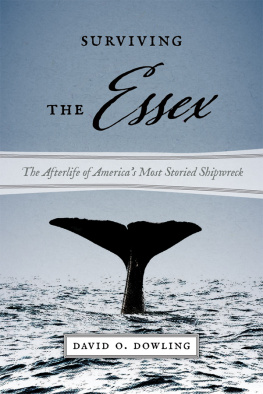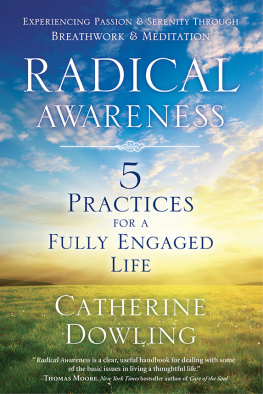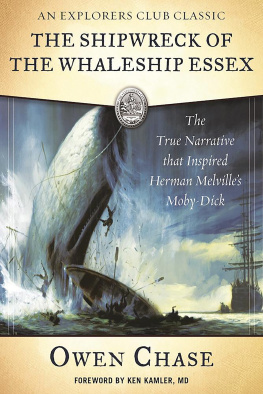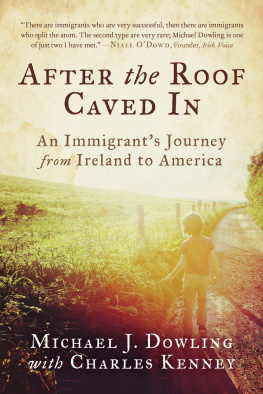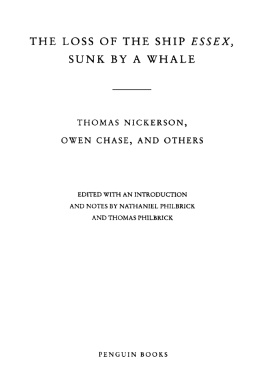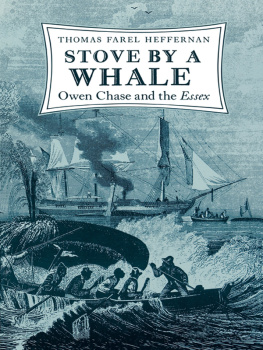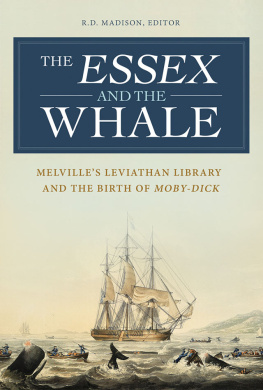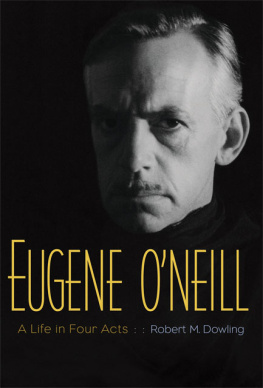Dowling - Surviving the Essex: the afterlife of Americas most storied shipwreck
Here you can read online Dowling - Surviving the Essex: the afterlife of Americas most storied shipwreck full text of the book (entire story) in english for free. Download pdf and epub, get meaning, cover and reviews about this ebook. City: Pacific Ocean, year: 2016, publisher: University Press of New England;ForeEdge, genre: Detective and thriller. Description of the work, (preface) as well as reviews are available. Best literature library LitArk.com created for fans of good reading and offers a wide selection of genres:
Romance novel
Science fiction
Adventure
Detective
Science
History
Home and family
Prose
Art
Politics
Computer
Non-fiction
Religion
Business
Children
Humor
Choose a favorite category and find really read worthwhile books. Enjoy immersion in the world of imagination, feel the emotions of the characters or learn something new for yourself, make an fascinating discovery.
- Book:Surviving the Essex: the afterlife of Americas most storied shipwreck
- Author:
- Publisher:University Press of New England;ForeEdge
- Genre:
- Year:2016
- City:Pacific Ocean
- Rating:3 / 5
- Favourites:Add to favourites
- Your mark:
- 60
- 1
- 2
- 3
- 4
- 5
Surviving the Essex: the afterlife of Americas most storied shipwreck: summary, description and annotation
We offer to read an annotation, description, summary or preface (depends on what the author of the book "Surviving the Essex: the afterlife of Americas most storied shipwreck" wrote himself). If you haven't found the necessary information about the book — write in the comments, we will try to find it.
Dowling: author's other books
Who wrote Surviving the Essex: the afterlife of Americas most storied shipwreck? Find out the surname, the name of the author of the book and a list of all author's works by series.
Surviving the Essex: the afterlife of Americas most storied shipwreck — read online for free the complete book (whole text) full work
Below is the text of the book, divided by pages. System saving the place of the last page read, allows you to conveniently read the book "Surviving the Essex: the afterlife of Americas most storied shipwreck" online for free, without having to search again every time where you left off. Put a bookmark, and you can go to the page where you finished reading at any time.
Font size:
Interval:
Bookmark:


ACKNOWLEDGMENTS
Among the many people who made this book possible, Nathaniel Philbrick deserves special recognition for initially inspiring it with his stellar history In the Heart of the Sea: The Tragedy of the Whaleship Essex. Much of the primary research for this project took place at the Nantucket Historical Association ( NHA ), where Elizabeth Oldham of the Research and Collections Department guided my exploration of the vast archive. Marie Henke and the staff were particularly accommodating in allowing me access to rare materials vital to this project. I would like to thank William J. Tramposch, Gosnell Executive Director of the NHA , for his enthusiasm and insights into the nature of whaling culture on Nantucket. Mark H. Procknik, librarian at the New Bedford Whaling Museum, was extremely helpful in providing access to materials for this project. Dr. Kelly Gleason Keogh, the archaeologist at the Papahanaumokuakea Marine National Monument ( PMNM ) who led the Two Brothers shipwreck project, deserves recognition for her encouragement and vital contribution to this research. The University of Iowa College of Liberal Arts and Sciences supplied essential travel funds. I am deeply indebted to all these individuals and institutions.
The development of the manuscript depended on the encouragement of the following people. My longtime friend Scott Baxter, Navy veteran and Melville aficionado, contributed ideas and materials that shaped this project. His passion is truly contagious, like that of Melville Society colleagues Timothy Marr, Daniel Goske, Peter Riley, A. Robert Lee, and Michael Jonik. Kind words regarding my Melville research from Hershel Parker and Sam Otter have been especially encouraging. I am particularly grateful for the generous support of John Bryant for my earlier work for the journal Leviathan, and Wyn Kelley for Chasing the White Whale. Thanks go to my former neighbor Louie Psihoyos, an Academy Awardwinning director (The Cove), for lending his wisdom on cetacean behavior for both the coda on the Essex whale, and a related work of digital journalism for Narrative.ly on Jaws author Peter Benchley. The conversation and collegiality of Martin Bickman and Jarad Krywicki enriched this book; Jarad and I were fortunate to present our papers in May 2014 on the same Melville Society panel at the American Literature Association Conference in Washington, D.C. I am indebted to my University of Iowa colleagues Ed Folsom, Brooks Landon, and Travis Vogan for their loyalty and camaraderie. George Cotkin and Elisabeth Chretien provided crucial feedback based on their perceptive readings of the manuscript. I appreciate the expertise and professional care of my editor, Richard Pult, and the staff at UPNE , who made this dream become a reality.
I would finally like to thank my wife, Caroline, and our children, Jacqueline, Eveline, and Edward, for their love and sympathy. Like the sea, the vitality they radiate is immeasurable.
Chapter 1

WHO SHOT OWEN COFFIN?
After the Essex collided with a whale on November 20, 1820, in the South Pacific west of the Galpagos Islands, most of the stunned crew determined to row their tiny open boats some three thousand miles east to the South American coast. Their decision was based in part on a fear of cannibals on nearby islands to the West. Covering such a vast distance into a formidable trade wind without restocking provisions along the way, however, seemed suicidal. Ducie Island, located due south, appeared an ideal spot to restock. After landing on Henderson Island, seventy miles west of Ducie, they soon found their resources depleted and abandoned their quest for the Chilean coast. Instead, they resolved to make the more reasonable journey to Easter Island, a third of the way to South America. Such a decision apparently reflected the crews diminished fear of cannibals and a corresponding willingness to employ their diplomatic skills to avert any danger. With acute starvation and malnutrition setting in, they felt they had no choice but to travel for the aptly named isle, site of their potential rebirth and resurrection.
But undoing their original plan to sail for South America proved more difficult than anticipated. This was because following that plan, and the journey to Henderson Island, had set them on a more difficult trajectory for Easter Island, which was a tantalizing several hundred miles due east of the wreckage site. In their ill-equipped open boats with makeshift canvas sails, which had been frantically slashed from the masts of the sinking Essex, the sailors were helpless against the stiff gales that tossed them about. The best trajectory they could muster was a derelict southeastern stagger.
That decision, at the wreckage site more than a thousand miles to the North, was engineered by the first mate, Owen Chase, who had roused the crews support to sail for the mainland, overturning Captain George Pollard Jr.s plan to cover one-third that distance, following a favorable southwesterly wind for the Marquesas Islands or Tahiti. The decision instead to sail due south placed them virtually out of reach of Easter Island, apparently dooming them to a slow journey toward South America. Like Sophocless Oedipus, who inadvertently kills his father and then does all he can to avoid the horrifying prospect of wedding his mother, the sailors may have tried to escape their fate, only to realize its grim inevitability. As is widely known, the Oedipus story centering on unintended consequences borne of good intentions seized the imagination of Sigmund Freud; likewise, the saga of the Essex, including its rich psychological elements, riveted antebellum readers.
The Essex trauma would feature its own archetypical taboos rivaling those of Oedipus Rex. Namely, Oedipus kills his own father, and Pollard issues the order to kill his own teenage cousin. As if randomly choosing a crew member to execute for sustenance were not weighty enough, Owen Coffin was the beloved son of Pollards aunt and uncle, with whom he had been close on Nantucket. On February 2, 1821, the day Coffin died, he was eighteen and Pollard was twenty-nine, making the captain something between a father and a brother figure to the youth, with whom he shared a family resemblance. And murder, in this instance, preceded cannibalism, adding to the realization of the crews, and Pollards, darkest nightmare.
The most conspicuous scene separating one Essex account from another is the shooting of Owen Coffin. No other detail is more contested, or retold with such ritual significance, as the drawing of lots that eventuated
Many retellings of the lottery exaggerated and sensationalized the facts for dramatic effect. Such rhetoric presumably reflected an attempt to divert attention from the savagery to follow. Thus the event and the actions of the sailors are characterized simultaneously as murderous and empathetic. In turn, this tableau of seeming contradiction resonated more than any other with those who encountered the story.
The sacrifice of Owen Coffin tapped for audiences a powerful realization that they, too, might draw the short straw in their personal lotteries. They also sympathized more basically with Coffins death. For Melville himself, the first reading of Chases narrative was moving precisely because he, sailing on the
Next pageFont size:
Interval:
Bookmark:
Similar books «Surviving the Essex: the afterlife of Americas most storied shipwreck»
Look at similar books to Surviving the Essex: the afterlife of Americas most storied shipwreck. We have selected literature similar in name and meaning in the hope of providing readers with more options to find new, interesting, not yet read works.
Discussion, reviews of the book Surviving the Essex: the afterlife of Americas most storied shipwreck and just readers' own opinions. Leave your comments, write what you think about the work, its meaning or the main characters. Specify what exactly you liked and what you didn't like, and why you think so.

